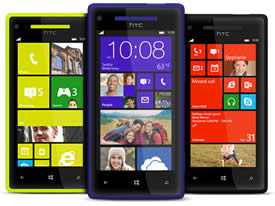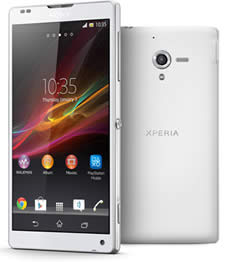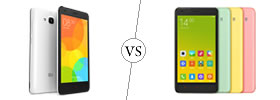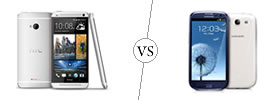Difference between HTC Windows 8X and Sony Xperia ZL
Key Difference: The HTC Windows 8X sports a 4.3- inch S-LCD2 capacitive touchscreen that provides a pixel density of 342ppi. The screen is protected using gorilla glass 2, which makes it pretty durable and less prone to scratches. The phone is pretty slick and slim, weighing only 130 grams with the battery. The Sony Xperia ZL is very similar to its counterpart the Xperia Z; however, it differs in some aspects and is also believed that it will be offered for a lower price compared to the Z. Sony has managed to make the ZL even smaller and more compact compared to the Z.
 HTC originally made many phones with Windows OS, before shifting its products to Android for drawing in more customers and profits. Recently, HTC has put focus on helping Windows boost its product range with the new HTC Windows 8X and the 8S phones. The phones are set to give direct competition to the Androids and the iPhones. The company has set out to prove that Windows can be just as stylish and productive as the other phones in the market. HTC has incorporated some of its best technologies on the Windows 8X. The phone was released in November 2012 and has been proven a success with many people.
HTC originally made many phones with Windows OS, before shifting its products to Android for drawing in more customers and profits. Recently, HTC has put focus on helping Windows boost its product range with the new HTC Windows 8X and the 8S phones. The phones are set to give direct competition to the Androids and the iPhones. The company has set out to prove that Windows can be just as stylish and productive as the other phones in the market. HTC has incorporated some of its best technologies on the Windows 8X. The phone was released in November 2012 and has been proven a success with many people.
The HTC Windows 8X sports a 4.3- inch S-LCD2 capacitive touchscreen that provides a pixel density of 342ppi. The screen is protected using gorilla glass 2, which makes it pretty durable and less prone to scratches. The screen itself has an excellent resolution and provides more ppi than the iPhone, giving the users a crisp, clear and sharp display screen. The phone is pretty slick and slim, weighing only 130 grams with the battery. The phone is encased in a polycarbonate chassis that is also durable and does not scratch easy. The matte finish on the back provides a firmer grip on the phone. The power/lock key is located on the top of the phone, while the tray with pin release hole, a volume rocker, and a camera button is placed on the right side of the device. The left side is bare and the bottom holds the charging socket and the primary mic. The buttons are said to be a little too flush, making it difficult to locate them on the screen by touch and even harder to press them.
Under the hood, the device is powered by 1.5 GHz Dual-core Qualcomm processor. It offers the Windows 8 OS, with the live tiles that are customizable based on the user’s preferences. The device offers 1 GB RAM and an internal storage capacity of 16 GB. This is one of the downfalls of the phone, as the 16 GB (minus the space required for internal software) is all the user gets for storage, as the device does not support SD cards. The device supports 2G and 3G networks in all areas of the world, while 4G is only available in certain countries such as the US.
The device houses an 8 MP rear camera for taking pictures and a 2.1 MP front camera for video calls. The rear camera comes with autofocus, BSI sensor and LED Flash, while the front camera has unlta-wide angle for allow more details to fit in the picture. The Ultra-wide angle is one of the newest features that is being offered in very few phones. Similar to other HTC phones the device comes with Beats Audio enhancement to make listening to movies and audio an unbelievable experience. In addition to Beats Audio, the device also comes with a built-in amp. The device has a non-removable 1800 mAh battery, a little less than the other phones available on the market. The major downfall with a Windows phone for many people is the lack of apps. However, the number of apps available in the Windows Store is growing slowly and should not be a problem for a long time.
 The Sony Xperia ZL is very similar to its counterpart the Xperia Z; however, it differs in some aspects and is also believed that it will be offered for a lower price compared to the Z. Sony has managed to make the ZL even smaller and more compact compared to the Z. The ZL maintains the 5-inch display in the dimensions 131.6 x 69.3 x 9.8 mm. The ZL offers the same processor, internal storage capacity, RAM and software. The ZL is also available with 4.1 Jelly upgradeable to v4.2. The ZL is also slightly heavier than the Z but it does not make that big of a dent on the design.
The Sony Xperia ZL is very similar to its counterpart the Xperia Z; however, it differs in some aspects and is also believed that it will be offered for a lower price compared to the Z. Sony has managed to make the ZL even smaller and more compact compared to the Z. The ZL maintains the 5-inch display in the dimensions 131.6 x 69.3 x 9.8 mm. The ZL offers the same processor, internal storage capacity, RAM and software. The ZL is also available with 4.1 Jelly upgradeable to v4.2. The ZL is also slightly heavier than the Z but it does not make that big of a dent on the design.
The major difference is ZL does not offer the dust and water resistance that is boasted by the Z. However, it does offer shatter-proof sheet and scratch-resistance glass on the front. The back isn’t the glass that is available in the Z but has a matte or textured finish, making it easier and more comfortable to hold. The ZL also has slight differences in button and SIM slow placement. The SIM and microSD card slots are placed on the bottom lower of the back panel, while in the Z the slots are placed above the power button on the right hand side. The ZL also offers a dedicated camera button which is not available in its big brother. The ZL also lacks contact points which are available with the Z. The contact points allow the phone to be connected to a charging dock that is sold separately. The placement of the front camera also differs. The front camera in the Z was located on left-hand corner, while in the ZL it is located in the right-hand corner. However, this does not make a difference when using the phone for video conferencing. Two new features that the ZL boasts is infrared/IrDA functionality and one-touch mirroring. The IR feature allows the phone to be used as a remote with any device that supports IR and one-touch mirroring allows the phone to send, receive and play audio and video files by touching another device that supports the feature. The ZL has yet to be launched and the price has also not been fixed for the device.
The information for the detailed table about the two phones has been taken from HTC website, guardian.co.uk, Sony Mobile website and GSMArena.com.
|
|
HTC Windows 8X |
Xperia ZL |
|
Launch Date |
November 2012 |
April 2013 |
|
Company |
HTC |
Sony Mobile |
|
Size |
132.35 x 66.2 x 10.12 mm |
131.6 x 69.3 x 9.8 mm |
|
Display |
4.3-inches S-LCD2 capacitive touchscreen |
5 inch scratch-resistant TFT |
|
Screen |
720 x 1280 pixels (~342 ppi pixel density) |
1920x1080 pixels, (~441 ppi pixel density) |
|
Protection |
Gorilla Glass 2 |
Shatter-proof sheet on scratch-resistant glass. |
|
Weight |
130 grams |
151 g (5.33 oz) |
|
2G Network |
GSM 850 / 900 / 1800 / 1900 |
GSM 850 / 900 / 1800 / 1900 - C6502, C6503, C6506 |
|
3G Network |
HSDPA 850 / 900 / 1900 / 2100 HSDPA 850 / 1900 / 2100 - for AT&T |
HSDPA 850 / 900 / 1700 / 1900 / 2100 - C6502, C6506 HSDPA 850 / 900 / 2100 - C6503 |
|
4G Network |
LTE 700 MHz Class 17 / 850 / 1700 / 1900 / 2100 |
LTE 700 / 850 / 1700 / 1900 / 2100 - C6506 LTE 800 / 850 / 900 / 1800 / 2100 / 2600 - C6503 |
|
GUI |
Windows Phone 8 UI |
Timescape UI |
|
CPU speed |
1.5 GHz Dual-core Qualcomm Krait |
1.5 GHz Quad-core Krait |
|
GPU |
Adreno 225 |
Adreno 320 |
|
OS |
Windows Phone 8 |
Android OS, v4.1.2 (Jelly Bean), planned upgrade to v4.2 (Jelly Bean) |
|
Chipset |
Qualcomm MSM8960 Snapdragon |
Qualcomm MDM9215M / APQ8064 |
|
RAM |
1 GB |
2GB |
|
SIM Size |
microSIM |
microSIM |
|
Internal Memory |
16 GB |
Up to 16 GB |
|
Expandable Memory |
No |
up to 32 GB |
|
Sensors |
G-Sensor, Digital compass, Proximity sensor, Ambient light sensor |
Accelerometer, gyro, proximity, compass |
|
Connectivity |
3.5 mm stereo audio jack, NFC capable, Bluetooth® 3.1, Wi-Fi®: IEEE 802.11 a/b/g/n |
4G LTE (100 mbps), GPS, GLONASS, USB, Bluetooth, NFC, Wi-Fi, DLNA and MHL. |
|
Data |
GPRS, EDGE, WLAN, Bluetooth, NFC, USB |
GPRS, EDGE, WLAN, Bluetooth, NFC, Infrared port and USB |
|
Speed |
HSPA+; LTE, Cat3, 50 Mbps UL, 100 Mbps DL (LTE only for AT&T version) |
HSDPA, 42 Mbps; HSUPA, 5.76 Mbps; LTE, Cat3, 50 Mbps UL, 100 Mbps DL |
|
WLAN |
Wi-Fi 802.11 a/b/g/n, dual-band |
Wi-Fi 802.11 a/b/g/n, dual-band, Wi-Fi Direct, DLNA, Wi-Fi hotspot |
|
Bluetooth |
Bluetooth v3.1 with A2DP, EDR |
Bluetooth v4.0 with A2DP |
|
USB |
microUSB v2.0 |
microUSB v2.0. |
|
Primary Camera |
8MP 3264 x 2448 pixels rear camera |
13 megapixel Exmor RS camera with Auto focus and flash |
|
Secondary Camera |
2.1 MP front camera |
2 MP 1080p Exmor R |
|
Video |
1080p@30fps |
HD video recording (1080p) at 30fps, continuous autofocus, video light, video stabilizer |
|
Camera Features |
|
|
|
Sound Enhancement |
Beats Audio Built-in amp |
xLoud Experience |
|
Audio supported formats |
.aac, .amr, .m4a, .mp3, .wav, .asf, .wma (verison 9 and 10) |
MP3/eAAC+/WMA/WAV/Flac |
|
Video supported formats |
.3gp, .3g2, .mp4, m4v, asf, .wmv (version 9 and 10) |
MP4/H.263/H.264/WMV |
|
Battery Capacity |
Non-removable Li-ion Polymer 1800 mAh |
Non-removable 2370 mAh Li-Ion battery |
|
Talktime |
No official data released |
Up to 10 hours |
|
Standby Time |
No official data released |
Up to 500 hours |
|
Available Colors |
California Blue, Graphite Black, Flame Red, Limelight Yellow |
Black, White, Red |
|
Messaging |
SMS (threaded view), MMS, Email, IM, Push Email |
SMS (threaded view), MMS, Email, IM, Push Email |
|
Browser |
HTML5 |
HTML5 |
|
Radio |
No |
Stereo FM radio with RDS |
|
GPS |
Internal GPS antenna with GLONASS |
Yes, with A-GPS support and GLONASS |
|
Java |
No |
Yes, via Java MIDP emulator |
|
Additional Features |
|
|
Image Courtesy: htc.com, sonymobile.com









Add new comment